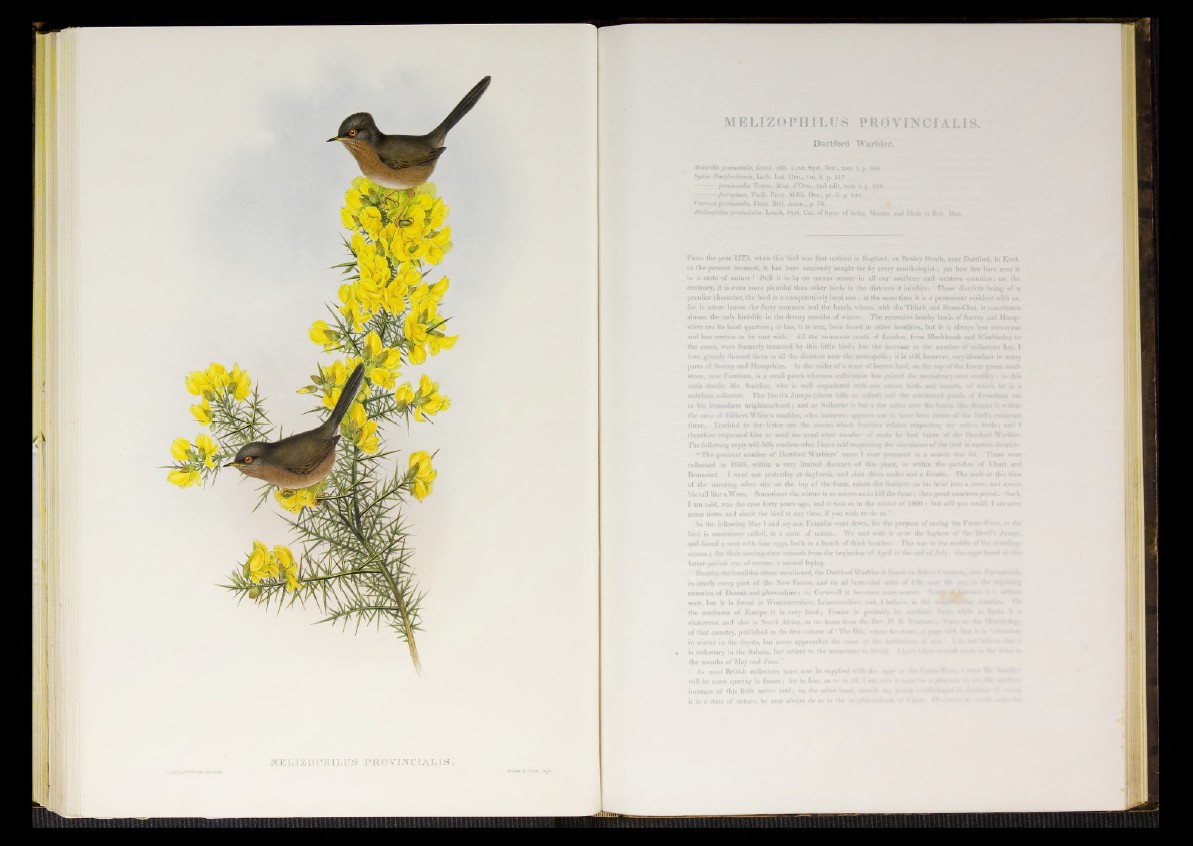
MELIZOPHXLITS P R O V IN C IA L !S .
MELIZOPHILUS PROVINCIALIS
Dartford Warbler.
Motacilla provincialis, Gmel. edit. Linn. Syst. Nat., tom. i. p. 958.
Sylvia Dart/ordiensis, Latli. Ind. Orn., vol. ii. p. 517.
----------provincialis, Temm. Man. d’Orn., 2nd edit. tom. i. p. 210.
----------ferruginea, Vieill. Ency. Meth. Orn., pt. iL p. 446.
Curruca provincialis, Flem. Brit. Anim., p. 70.
Melizc-phihis provincialis, Leach, Syst. Cat. of Spec, of Indig. Mamm. aud Birds in Brit. Mus.
F r o m the year 1 7 7 3 , when this bird was first noticed in England, on Bexley Heath, near Dartford, in Kent,
to the present moment, it has been anxiously sought for by every ornithologist; yet how few have seen it
in a state of nature! Still it is by no means scarce in all our southern and western counties; on the
contrary, it is even more plentiful than other birds in the districts it inhabits. Those districts being of a
peculiar character, the bird is a comparatively local o ne; at the same time it is a permanent resident with us,
for it never leaves the furzy common and the heath, where, with the Titlark and Stone-Chat, it constitutes
almost the only bird-life in the dreary months o f winter. The extensive heathy lands of Surrey aud Hampshire
are.its head quarters; it has, it is true, been found in other localities, but it is always less numerous
and less certain to be met with. All the commons south of London, from Blackheath and Wimbledon to
the coast, were formerly tenanted by this little bird; but the increase in the number of collectors has, I
fear, greatly thinned them in all the districts near the metropolis; it is still, however, very abundant in many
parts of Surrey and Hampshire. In the midst o f a tract of barren land, on the top of the lower green sandstone,
near Farnharo, is a small patch whereon cultivation has gaimtd the ascendency over sterility; in this
oasis dwells Mr. Smither, who is well acquainted with our native birds and insects, of which he is a
sedulous collector. ■ The Devil’s Jumps (three hills so called) and the celebrated ponds of Frencbara are
in hi* immediate neighbourhood; and as Selborac i* hut a few miles over the heath, this district is within
the area of Gilbert White’s rambles, who, however, ;q>j sears not to hare been aware of the bird's existence
there. Truthful to the letter are the stories which Smither relates respecting our native birds; ami I
therefore requested him to send me word what number of nests be had taken of the Dartford Warbler.
The following reply will fully confirm what I have said respecting the abundance of the bird in certain districts.
“ The greatest number of Dartford Warblers’ nests I ever procured in a season was 65. These were
collected in 1859, within a very limited distance of this place, or within the parishes of Churt and
Bramshot. I went out yesterday at daybreak, aud shot three males and a female. The male at this time
of the moruing often sits on the top of the furze, raises the feathers on his head into a crest, and erects
his tail like a Wren. Sometimes the winter is so severe as to kill the furze; then great numbers perish. Such,
I am told, was the case forty years ago, and it was so in the winter of 1860 ; but still you could, I am sure,
come dowu and shoot the bird at any time, if you wish to do so.”
In the following May I and my son Franklin went down, for the purpose of seeing the Furze-Wren, as the
bird is sometimes called, in a state of nature. We met with it near the highest of the Devil's Jump*,
and found a nest with four eggs, built-in a bunch of thick heather. This was in the middle o f the breeding -
season ; for their nesting-time extends from the beginning of April to the end of J m.Iv t the ege* found at dolatter
period an*, o f course, n second laying.
Besides the localities above mentioned, the Dartford Warbler i* found on Scfew»» Common, near Portsmouth,
in nearly every part of the New Forest, and on all fursse-dad sides of hilt* wear the « « , m the adjpnmfig
comities of Dorset and Devonshire; in Cornwall it becomes more scarce. i
seen, but it is found in Worcestershire, Leicestershire, and, I believe, in Iht
the continent of Europe it is very local; France is probaMy its mhIIncs lb»«, while in Spam i
numerous, and also in North Africa, as we learn from the Kei. H. B. Trwtnim < Vue* o*» »we On»ith»wogy
of that country, published in the first volume of ‘The Ibis,' where he -mu-
in winter in the dayats, but never approaches the ouses or the taMf
is sedentary in the Sahara, but retires to the mountain* to breed. I
the months of May and June.”
As most British collectors must now be supplied with tU «gg»
will be more sparing in future; for to him, as to as an, I am «u
increase of this little native b ird ; on the other hand, shwiU any ««w
it in a state of nature, he may always do so in the ne«gbfe«**r